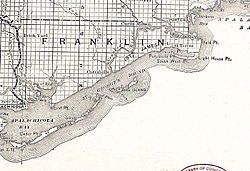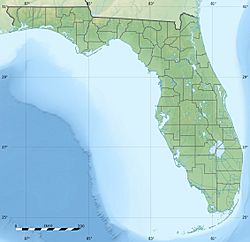St. James Island facts for kids

1888 map of Franklin County showing St. James Island
|
|
| Geography | |
|---|---|
| Coordinates | 29°57′04″N 84°31′36″W / 29.95111°N 84.52667°W |
| Length | 20 mi (30 km) |
| Width | 4 mi (6 km) |
| Administration | |
| State | Florida |
| County | Franklin |
St. James Island is a place where people live in Franklin County, Florida. It is located along the Florida Panhandle, which is the northwestern part of Florida. This area is surrounded by several bodies of water. These include the Carrabelle River, Crooked River, Ochlockonee River, and St. George Sound.
The island is quite large, stretching over 20 miles (32 km) long. It is also about 4 miles (6.4 km) wide on average. The Crooked River separates St. James Island from the mainland. This river is "tidal," meaning its water level changes with the ocean's tides. A cool fact about St. James Island is its highest point. It reaches 70 feet (21 m) above sea level. This makes it the highest spot on the Gulf coast of Florida between Pensacola and Tampa.
Communities on the Island
St. James Island is home to several towns and communities. The city of Carrabelle is located here. Other communities include Lanark Village, St. Teresa, and Alligator Point.
Natural Areas
A big part of the island is dedicated to nature. Bald Point State Park is found on the eastern side of the island. This park is a great place to explore Florida's natural beauty. Another section of the island is part of Tate's Hell State Forest. These natural areas help protect the local plants and animals.
What People Do Here
For a long time, people on St. James Island worked in certain industries. They used the land for timber, which means cutting down trees for wood. Commercial fishing was also very important. Fishermen would catch seafood to sell.
More recently, the island has become popular for other reasons. Tourism is growing, with visitors coming to enjoy the beaches and nature. Many people also choose St. James Island for retirement. This means they move here after they stop working. Even though it's an island, locals often don't call it an "island" in everyday talk.


